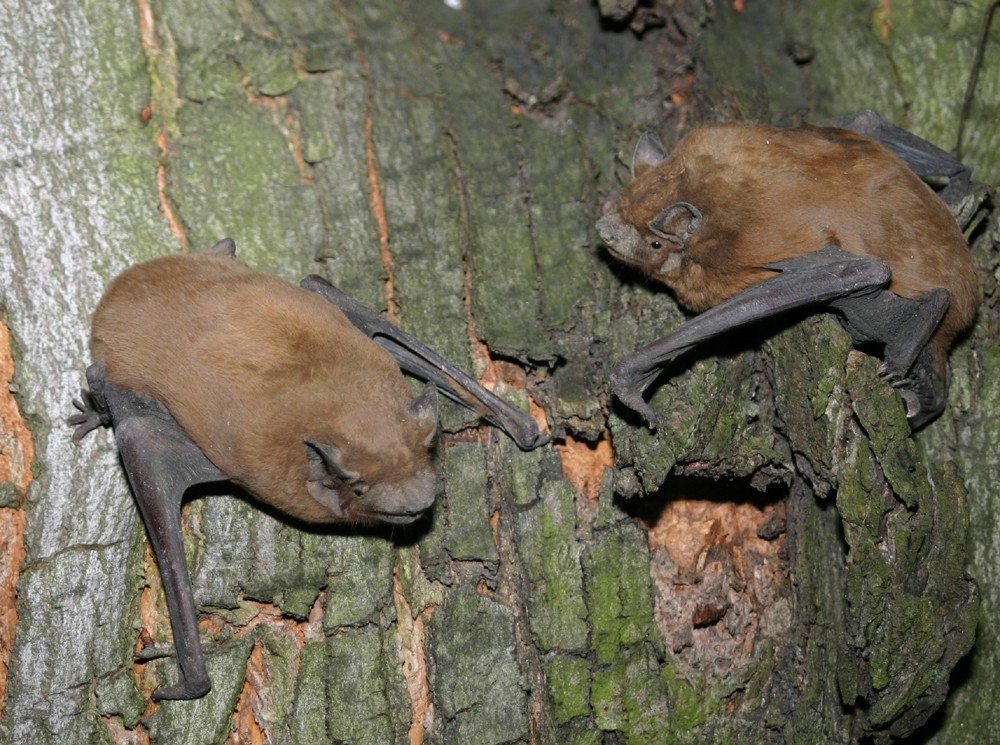Common noctule
A species of Noctule bats Scientific name : Nyctalus noctula Genus : Noctule bats
Common noctule, A species of Noctule bats
Botanical name: Nyctalus noctula
Genus: Noctule bats
Description
The short fur is dark brown after moulting in June (males) or July/August (females); later it changes to red-brown before the onset of winter. When awake, the body temperature is 36.5 °C (97.7 °F) but it decreases significantly during inactivity. The body mass of adult N noctula is 25–30 g (0.88–1.1 oz) and they have a wingspan of 37–40 cm (15–16 in). The species forages with a rapid flying speed of 20–40 km/h (12–25 mph), sometimes up to 60 km/h (37 mph). Because of temporally limited availability of insect prey, they have short daily activity periods before sunrise and after sunset of in total one hour or less and so must cope with up to twenty-three hours of fasting a day. 
Size
5 - 10 cm
Life Expectancy
8-12 years
Nest Placement
Cavity
Feeding Habits
Common noctule primarily consumes beetles, moths, and winged ants, hunting them in flight using echolocation. Specialized feeding adaptations include agile flying and acute hearing for nocturnal foraging.
Habitat
Small to medium-sized woodlands, tree holes, bat boxes attached to tree trunks, wooded habitats, towns, cities 
Dite type
Insectivorous
Migration Overview
The common noctule is a migrating species with female bias, meaning that the females migrate but the males do not. Mating season is in late summer in the wintering areas, and the females store the sperm in the uterus during hibernation until fertilization in spring. During early pregnancy in late April the females migrate north, as far as the Baltic region, to return to their natal maternity colonies and give birth after being pregnant for six to eight weeks. Each female rears one or two young per year. At birth the offspring is about a third of the maternal body weight, and after three to four weeks of suckling the young leave the roost almost fully developed – so the female rears the offspring to full size entirely on milk. Male N noctula do not migrate, but scatter along the females' migration routes to have higher chances of attracting the first females migrating back to the wintering regions. The reproductive cycle of male bats seems to correspond directly to season and food availability and spermatogenesis can be affected by body condition. In early autumn, males develop large testes and aim to attract females with singing calls. While in the harem roosts, males often do not enter torpor, but stay awake and mobile to defend the females from other males trying to copulate. Another reason for the avoidance of torpor during late summer and early autumn can be that spermatogenesis in bats can be delayed when resting metabolic rate is depressed, i.e. during torpor and hibernation. During the summer, male noctules are solitary or form small bachelor groups. In Europe, the young are reared mainly in the northern parts of the distribution area, north of roughly 48°–49°N latitude. With the exception of the main breeding area, several smaller and isolated breeding areas are known – recorded in Slovakia, Hungary, Bulgaria, Slovenia, Iberian Peninsula and Italy. 
General Info
Feeding Habits
Bird food type
Behavior
Common noctule is a nocturnal species known for its long-range migratory behavior. This typically solitary bat forages in flight, covering long distances in search of insect prey. Common noctule exhibits noticeable seasonal behavior, roosting in tree cavities during summer and utilizing a variety of structures for hibernation during winter.
Distribution Area
Most parts of Europe, central Russia, across the Ural mountain, Caucasus, Turkey, the Near East, to southwestern parts of Siberia, the Himalayas, China, Malaysia, Taiwan and Japan. In Bulgaria it is widespread, prefers deciduous forests. 
Species Status
This species is protected in the European Union under the Habitats Directive. It is also listed in the Berne Convention and is specifically targeted by the UNEP-EUROBATS convention. Several national legislatures also protect this species and its habitats. In order to highlight the importance of protecting this species at the European scale, it was selected as "Bat species of the Year" 2016 and 2017 by the pan-European NGO BatLife Europe. 
Scientific Classification
Phylum
Chordates Class
Mammals Order
Bats Family
Evening birds Genus
Noctule bats Species
Common noctule 